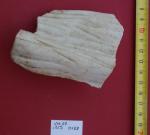
Description
- 138
- Drapery fragment of female costume
- 3rd c. AD?
- Densely grained white marble (Italian) with no streaking, polished to a 'soapy' surface.
- Ht.8.5 cm max. (right), 3.8 cm, min. (left); w. 6.9 cm, th., max. 3.5 cm Grooving, ca 1 mm deep. Undercutting on the fold at bottom right, ca 1 cm as preserved
- Broken across above and on the left of the rectangular fragment; broken jaggedly at right below; preserved edges are at right, and at left bottom. The back surface is well preserved. Surface polish is partially preserved, with little scarring, and a few dark encrustations.
- Fragment of drapery in thin cloth, with scattered roughly vertical lines incised with the point or fine chisel and then smoothed, in the a penna style of post-Antonine Roman sculpture. At right is preserved an almost completely rounded edge, suggesting that this segment of drapery would come from a sizable segment of dress undercut to hang away from the body. The lines of slight surface folding are cut diagonally across the two undulations, as on a figure in motion, gently windblown. At lower left is preserved the lower edge of a small drapery flute, undercut only slightly. The fragment most resembles the upper, overfold section of a chiton girt peplos-style.
- The fragment closely resembles the drapery of the Amazon group, S6, but cannot come from the chiton hem, which is entirely preserved. Therefore, it comes either from some separate element of drapery on that statue, such as a mantle hanging from the Amazon’s lost arm, or from another statue with the same visual impact [?] as the Hercules group and associated with it in a series.















![Download [view]](/villamagna/ark//skins/villamagna/images/results/download_sml.png)
